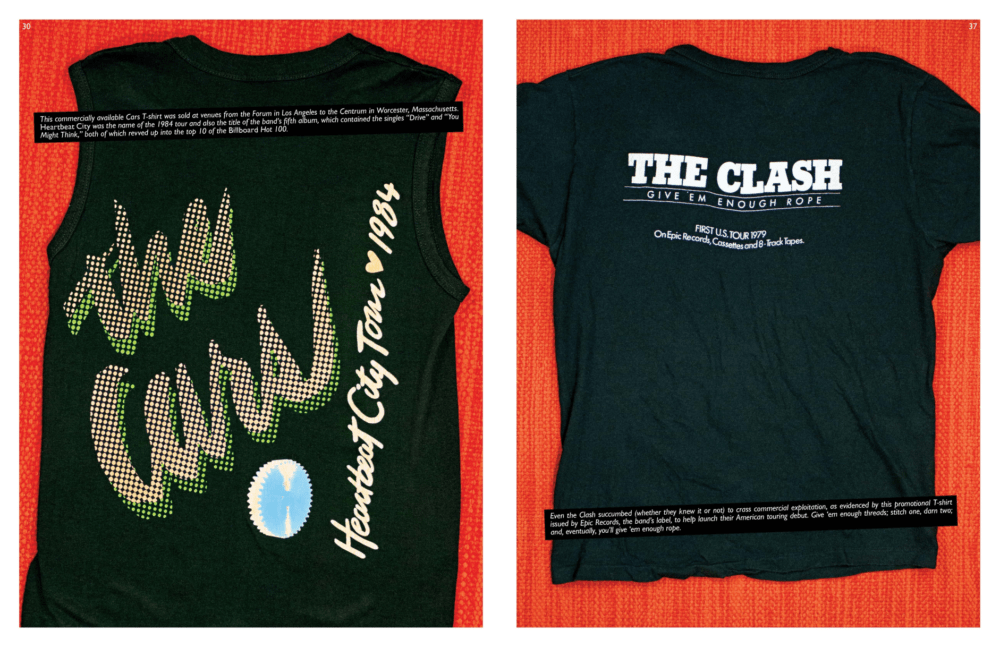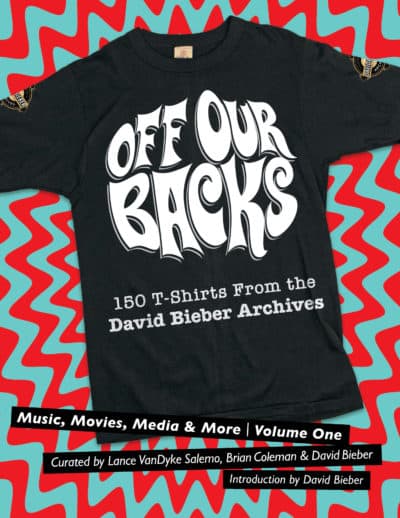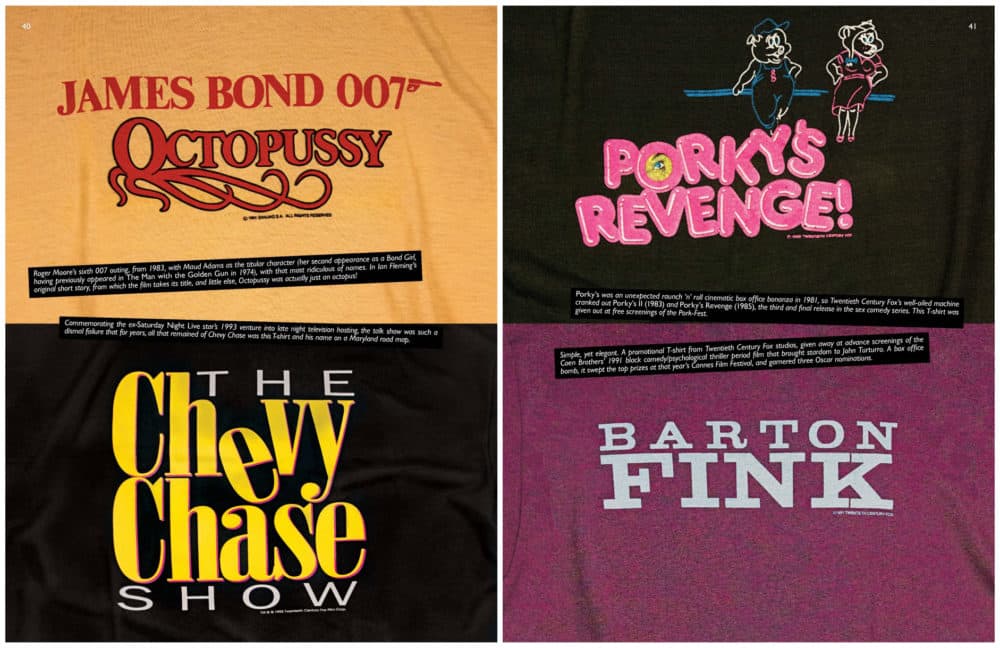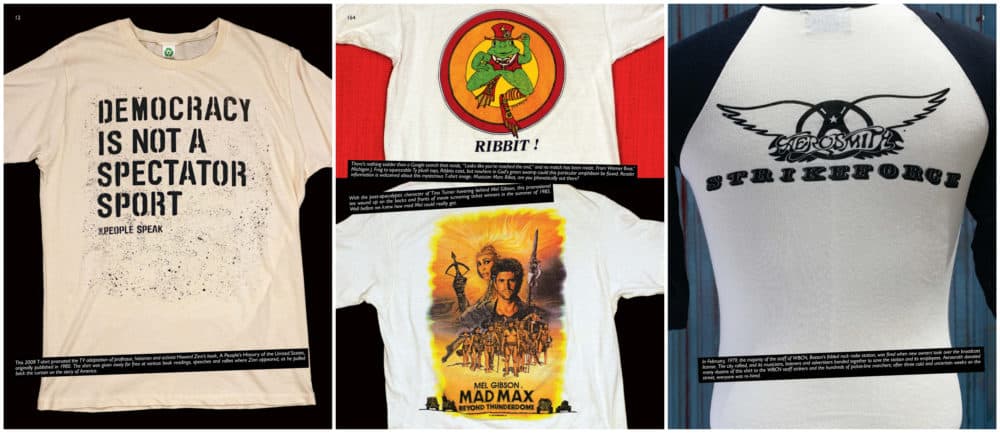Advertisement
New Book 'Off Our Backs' Explores The Cultural Cachet Of T-Shirts

I was a 22-year-old freelance rock journalist in the fall of 1978, writing mostly for the long-gone Sweet Potato music magazine, and shortly thereafter, began contributing to the Boston Globe. Just prior to the release of The Clash’s second album (but their first in the U.S.) “Give ‘Em Enough Rope,” their record company CBS/Epic sent me, along with many other critics, the iconic simple white-on-black T-shirt. The company had been touting The Clash as “The only band that matters” — which was a stupid boast and one the band hated — but they were at the top of their game; their February 1979 local debut at the Harvard Square Theatre was highly anticipated.
I was proud to wear that shirt. It told people in an instant what I was about. The music, the politics, the sense of punk rock righteousness. And I must admit there was an added cachet because the shirt was not commercially available; it served as a badge of insider inclusivity, too.

It’s that mindset, at least in part, that David Bieber — former promotions director at WBCN and later WFNX/Boston Phoenix – tapped into when he and his colleagues, Lance Salemo and Brian Coleman, assembled the book “Off Our Backs” (out Sept. 15), consisting of 150 annotated photos of T-shirts covering music, movies, politics and more from the ‘60s onward. It is Volume 1; they culled from roughly 5,000 shirts Bieber has in his massive warehouse of pop culture items and artifacts called David Bieber Archives in Norwood.
“These now-historic and valued shirts were a badge of honor,” writes Bieber in the book’s forward, “a sort of visible secret hand shake; your affiliation, your ‘colors,’ an item that said you were in the music biz, in ‘the industry,’ a catalytic factor in underground media or involved in midnight screenings at independent movie theatres. You couldn’t buy your way into the tribe. The unique promo shirts weren’t commercially available.”

Bieber notes that subcultures from hippie to punk shared a “common canvas.” “Looking back to long-gone decades, yes, the T-shirt, along with the so-called ‘blue jeans,’ broke down the 20th century’s dress code rigidity and clothing barriers and boundaries.”
“Off Our Backs,” Bieber says on the phone from his West Roxbury home, was “meant to connect dots of history and collective culture in all respects — T-shirts related to sports, religion and politics, not only popular culture or media. It’s kind of a microcosm.”
Some of the T-shirts certainly have local connections, as indicated by the various (now defunct) radio stations, and a chunk of rock bands like Aerosmith, The J. Geils Band and The Cars. But the intent is to cover a broad spectrum that should translate equally well outside of town. George Carlin and Rodney Dangerfield are represented; George Jones and Janet Jackson; Archie and The Simpsons; Abbie Hoffman and Howard Zinn too.
The T-shirt book arose out of a much larger project. Bieber had collected stuff — from comics to vintage radios, trading cards to jukeboxes — since his childhood in Cleveland, but his boxed-up memorabilia was not exactly in ship-shape order. For a couple of decades, he haunted flea markets early on Sunday mornings.
He was open to buying others’ collections or accepting donations. “I don’t have to personally have attained everything in a first-person experience,” Bieber says. “I’m receptive of being protective of others’ toys and trinkets, but I’m not desperate to have anything. The Archives is a celebration of what other people have created.”
The Archives began to take shape in 2017, when Bieber and company moved 8,500 boxes containing nearly two million items from a storage facility in Avon, Massachusetts, where they’d been since the mid-‘80s, to a 10,000-square foot second floor expanse in Norwood they call the Space Center. A tour of the Archives reveals a cornucopia of pop culture manifestations, from obscure rock magazines to horror movie posters.

“I have untold treasures to be discovered still that I maybe saw for 12 seconds 30 years ago,” he says, discussing his rediscoveries. Some of the treasures, he readily admits, others would call “detritus.” Other items have more value, both emotional and financial. The collection is now about 65% unearthed and in place. Bieber is always acquiring, but never selling.
“This hasn’t been a monetary mission,” Bieber says. “I did not build [the] collection with intent of selling. But I have watched the marketplace emergence of every category I have; they’ve become expensive respected categories. It’s hard to believe they’re obtaining prices like they are for ‘80s vintage video games at auction houses.”
It’s not a museum, exactly. “It’s not open to the public,” Bieber says, “but I want the content as available as possible. We have had events on-site, a controlled situation in an artist-oriented community, open houses for a handful of people.”

There’s also a mix of permanent and pop-up exhibitions around greater Boston, including at the Boch Center - Wang Theatre for the Folk Americana Roots Hall of Fame, The Verb Hotel and a one-off installation at The Cabot.
As to those 5,000 T-shirts, which would Bieber proudly wear now?
Probably none of them, the shirts being in the Archives and all. But if he did — “I prefer simple, but elegant, the things that don’t have a lot going on,” Bieber says. “The Stuff magazine black one, the Barton Fink one, the one with Mitch [from the Rat club].”
